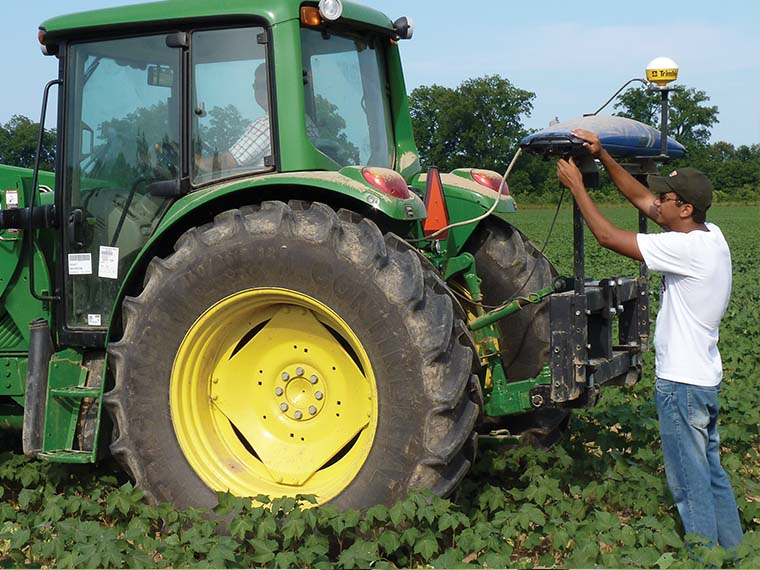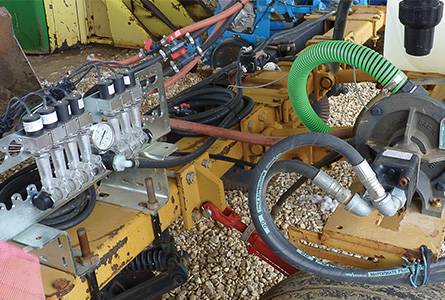Researchers assess plant health for nitrogen prescription
MSU scientists use precision agriculture in soil fertility research.
By: Vanessa Beeson
The information presented on this page may be dated. It may refer to situations which have changed or people who are no longer affiliated with the university. It is archived as part of Mississippi State University's history.
Determining the right amount of nitrogen for crops can be a challenge for Mississippi producers. If there isn't enough nitrogen, yield is sacrificed, while an excess amount can result in nutrient loss which can negatively impact the crop and the environment. Achieving optimal efficiencies in nitrogen management is essential in decreasing costs while increasing environmental stewardship.
Nitrogen is constantly influenced by biological organisms, texture, and water content in the soil. Varying soil textures contain a wide range of available soil nitrogen. When soils receive excessive rainfall, nitrogen losses can occur through leaching, especially on sandier, textured permeable soils, while denitrification can be more prevalent on clayey less permeable soils. While grid-sampling works well with nutrients like phosphorus and potassium, the volatility of nitrogen makes it a moving target. MAFES scientist Jac Varco is looking to the crop itself to unlock the secrets of this elusive nutrient.
The definition of an efficient nutrient management program is to supply plant nutrients in adequate quantities to sustain maximum crop productivity and profitability, while minimizing environmental impacts and nutrient use. Varco, a professor in MSU's Plant and Soil Sciences, strives to improve efficiency in this process through his research in precision agriculture and variable rate fertilizer nitrogen application.
A variable rate fertilizer nitrogen application delivers the right amount of nitrogen in the right place at the right time ensuring the plant gets the nitrogen it needs to produce consistent yield across the field.
Varco looks at cotton and corn plants, which need a specific amount of nitrogen to flourish and grow. Varco's team is currently using a tractor-mounted sensor to measure relative differences in crop size, biomass, leaf area, and plant greenness to determine how much nitrogen is needed.
"We measure the light reflected off of the leaves to determine the health and vigor of the cotton plants," Varco said. "My research centers on building relationships and, ultimately, models that correlate the imagery, or crop sensor data, with the nitrogen status of the plant. We then build a prescription application for nitrogen based on the needs of the crop."
Through extensive research, the team is improving end-use efficiency in nitrogen management for producers.
Chris Bush, a cotton producer with New Hope Farms north of Greenwood, Mississippi, was interested in variable rate nitrogen application.
"We have varying soil types so we knew variable rate nitrogen was something we'd like to try," Bush said. "We didn't have the equipment or experience so when I spoke with Jac Varco about his work at Mississippi State; it seemed like a good opportunity."
Varco applied a variable rate side-dress application on approximately 20 acres on the farm in 2013 and is repeating the study on a smaller plot this year. The research was conducted on both sandy loam and heavy clay soils.
"I was surprised at the consistency of the cotton plants across the varying soil types. The plants didn't grow excessively in the loam and weren't too short in the clay," Bush said. "We are excited about the research's potential to save money and increase yield consistency across the field, while limiting nitrogen use."
The results showed the sensor-based fertilization is capable of either decreasing the amount of nitrogen applied while maintaining yield or increasing yield with slightly more nitrogen.
"Our producers are already doing a good job. We are simply fine-tuning the system to make small but significant improvements," Varco said. "If we get this right, producers will be able to meet the needs of the crop, increase profitability, and minimize the risk of nitrogen loss."
Our producers are already doing a good job. We are simply fine-tuning the system to make small but significant improvements.
Jac Varco


